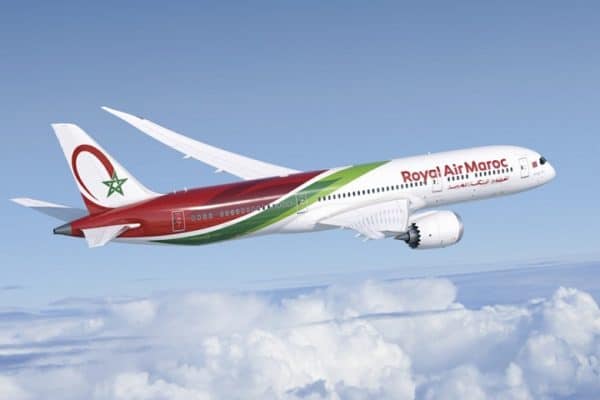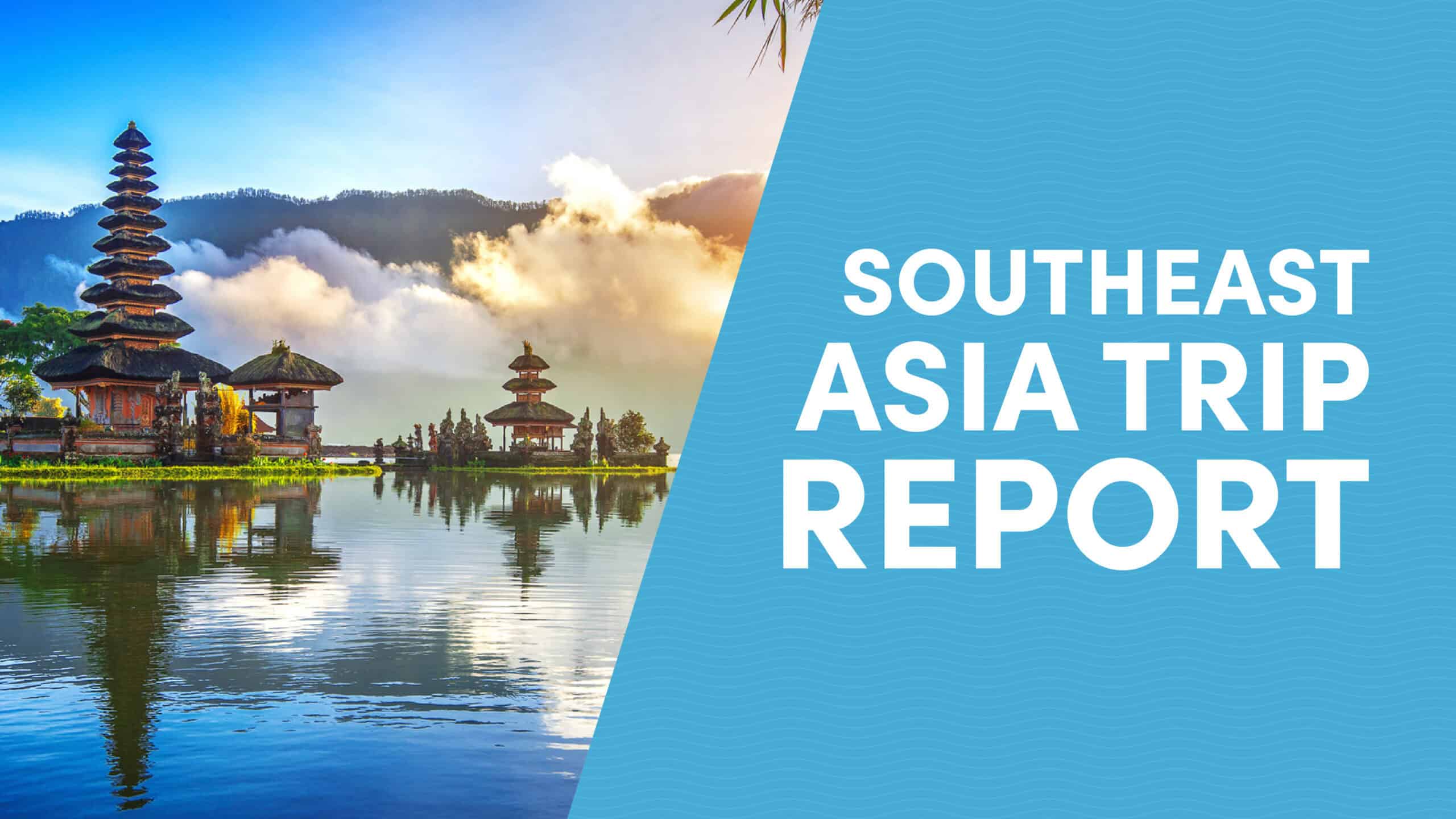
10xTravel is part of an affiliate sales network and receives compensation for sending traffic to partner sites, such as CreditCards.com. This compensation may impact how and where links appear on this site. This site does not include all financial companies or all available financial offers. Terms apply to American Express benefits and offers. Enrollment may be required for select American Express benefits and offers. Visit americanexpress.com to learn more. All values of Membership Rewards are assigned based on the assumption, experience and opinions of the 10xTravel team and represent an estimate and not an actual value of points. Estimated value is not a fixed value and may not be the typical value enjoyed by card members.
Note: Some of the offers mentioned below may have changed or may no longer be available. The content on this page is accurate as of the posting date; however, some of our partner offers may have expired. You can view current offers here.
- Lounge Review: United Polaris Lounge Washington (IAD)
- Flight Review: United Airlines Business Class Washington (IAD) to Frankfurt (FRA)
- Flight Review: Thai Airways Business Class Frankfurt (FRA) to Bangkok (BKK)
- Hotel Review: DoubleTree Resort by Hilton Penang
- Hotel Review: Grand Hyatt Bali
- Hotel Review: Alila Kuala Lumpur Bangsar
- Lounge Review: Japan Airlines Lounges Tokyo (NRT)
- Flight Review: Japan Airlines Business Class Tokyo (NRT) to San Diego (SAN)
For several years, I traveled almost annually to Asia, but I haven’t been there since 2018 due to alternate travel plans and COVID-19. I finally was able to return to Southeast Asia in early 2023.
Why I’m Traveling to Southeast Asia
Since 2011, Southeast Asia has been one of my favorite places to travel during the United States winter due to Southeast Asia’s climate, reasonable cost and interesting culture. Southeast Asia generally has a warm to hot climate. In many parts of Southeast Asia, December through March are part of the dry season. Accommodations and food are relatively inexpensive in many countries in Southeast Asia. I love the culture and food in the countries I have visited in the region.
For this trip, I was looking forward to:
- Revisiting Malaysia and Vietnam: I wanted to explore other parts of these countries that I missed on my initial trips and spend a few days in Kuala Lumpur, Malaysia, which I visited for two nights in 2017.
- Catching up with friends: Although I hadn’t initially planned on visiting Indonesia, I added Bali, Indonesia to my trip when I found out that my friends were going to be there during the period I had planned for a beach destination.
- Traveling in long-haul business class: All of my travel between March 2020 and January 2023 was within North America with flights in economy class, so I was excited to use points and miles for elevated flight experiences.
My trip included the following international destinations for overnight stays:
- Kuala Lumpur, Malaysia
- Penang, Malaysia
- Bali, Indonesia
- Hanoi, Vietnam
The Airlines I’m Flying
I booked long-haul international flights beginning in April 2022, before the places I planned to visit had reopened to international travelers and with many pre-pandemic flights not operating. Given the uncertainty about whether travel to all planned destinations would be possible and what the experience would be like, I focused on airline programs where I could book award flights with the ability to cancel and get points returned without any cancellation or mile redeposit fees, if necessary. In addition, I chose to avoid some connecting airports, given the situation at the time.
I also sought opportunities to:
- Use miles that I already had in airline programs rather than transferring flexible currency, to avoid stranding miles in other programs if flights were canceled.
- Book awards that required a reasonable number of miles.
- Fly long-haul segments on airlines offering lie flat business-class seats and generally good business-class products.
- Fly on airlines that I hadn’t previously flown in international business class.
I met most of these objectives with the flights I booked, although I did have some suboptimal connections.
United States to Southeast Asia Flights
For travel to Malaysia, I flew on United Airlines and Thai Airways. I secured a one-way business class award ticket for 60,000 United MileagePlus miles when United released a lot of international award space at that rate to many regions. My flights included:
- United economy class from Buffalo (BUF) to Washington (IAD): This flight was about one hour on a smaller regional jet that only had economy class.
- United business class from Washington (IAD) to Frankfurt (FRA): I wrote a separate review for this flight.
- Thai Airways business class from Frankfurt (FRA) to Bangkok (BKK): I wrote a separate review for this flight.
- Thai Airways business class from Bangkok (BKK) to Kuala Lumpur (KUL): This was a business class flight of just over two hours on a Boeing 787-800 with lie-flat seats. This seat was noticeably nicer than the seat on the Thai Airways flight from Frankfurt to Bangkok. Despite the short flight, service was excellent, and a full meal was served. The flight attendants were accommodating in changing my seat when my selected seat somehow got switched.
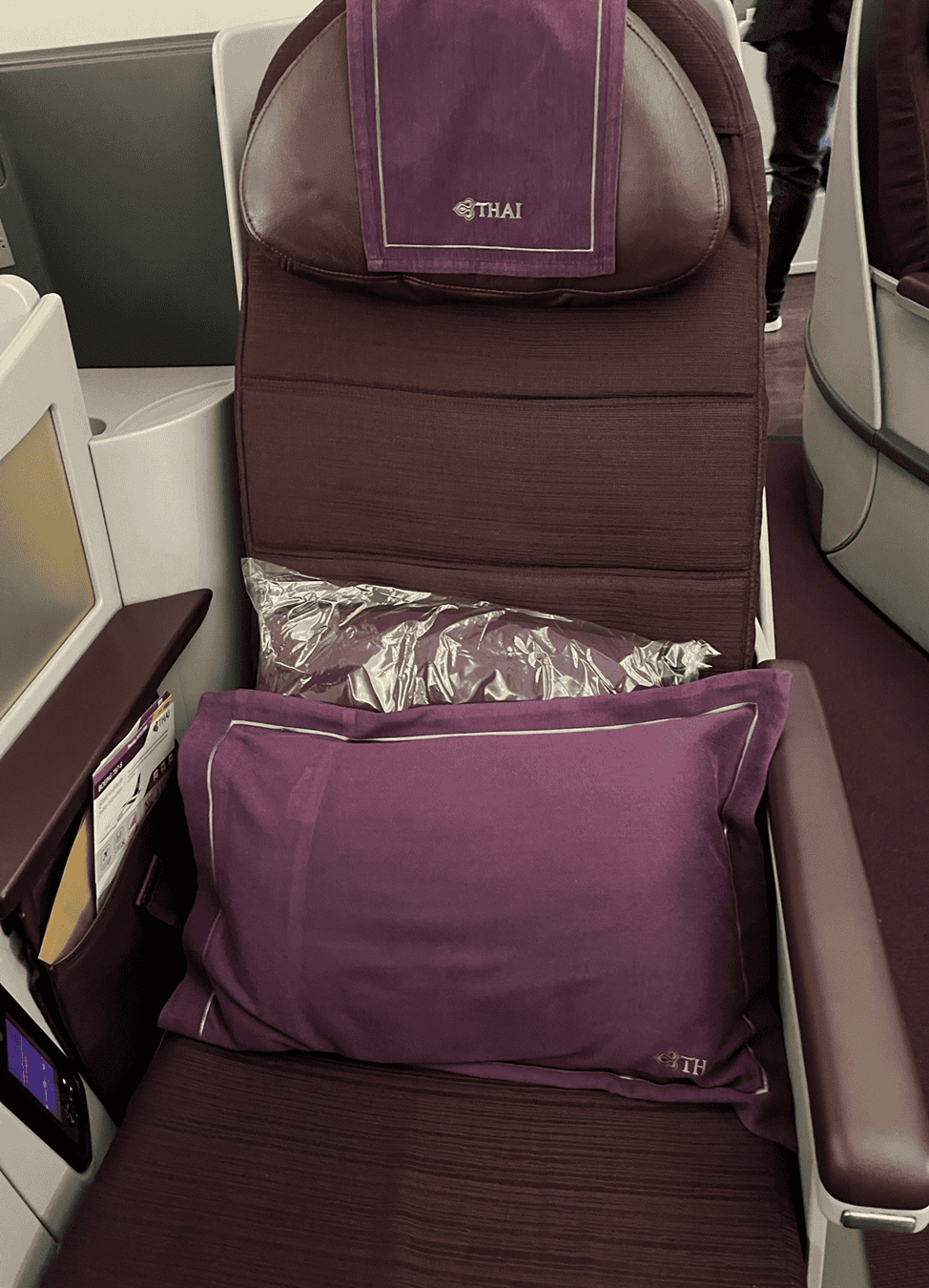
Thai Airways 787-800 business class seat | Photo by Julie Neafach
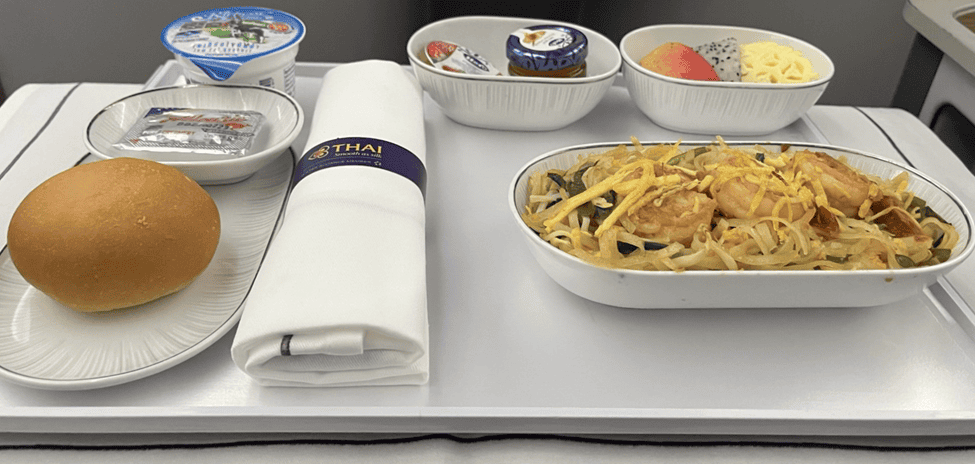
Thai Airways short flight meal: Shrimp pad thai, yogurt, fruit, and roll | Photo by Julie Neafach
Intra-Asia Flights
My flights within Asia were the opposite experience from international business class, since I flew on a low-cost carrier, AirAsia. Given that the longest flight segments were about three hours, I was fine with economy class travel. I purchased tickets through the Capital One travel portal to use part of a $300 annual travel credit for purchases through Capital One Travel, which is a benefit provided through my Capital One Venture X Rewards Credit Card.
Since I booked through Capital One, I paid AirAsia separately for my checked bag and seat assignment. For reference, these fees are least expensive if purchased from AirAsia in a value package at the same time you book flights, but you can’t purchase value packages when booking flights through a third party. It’s still less expensive to purchase baggage allowances online in advance compared to doing this at the airport.
I flew Air Asia on two routes: Penang (PEN) to Bali (DPS) and Bali (DPS) to Hanoi (HAN). Both flights involved connecting through Kuala Lumpur (KUL). I initially had booked a nonstop flight between Penang (PEN) and Bali (DPS), but AirAsia canceled it, and all their other flights that day involved connections. It was pretty easy to change flights online with no additional charge.
The actual flight experience was fine, and it wasn’t much different from flying economy in the U.S. The two exceptions were: no complimentary beverages or snacks and a low included carry-on baggage weight allowance of 15 pounds/7 kilograms. Despite checking a bag, I barely managed to keep my carry-on under the weight limit.
Southeast Asia to United States Flights
My flights back to the U.S. were in business class on Japan Airlines for the international flights and in the business/first cabin on American Airlines for U.S. connecting flights. I selected these airlines for the same reasons discussed above.
I booked the inbound flights using 70,000 American AAdvantage miles. Flights on this ticket included:
- Japan Airlines business class flight between Hanoi, Vietnam and Tokyo
- Japan Airlines business class flight between Tokyo and San Diego: I wrote a separate review for this flight.
- American Airlines first class between San Diego and Philadelphia
- American Airlines first class between Philadelphia and Tampa, Florida
Japan Airlines Flight to Tokyo
The Japan Airlines business class flight from Hanoi (HAN) to Tokyo (NRT) departed around midnight with a scheduled duration of 4 hours 45 minutes. It was on a Japan Airlines 787-900 with a 1-2-1 reverse herringbone configuration in business class. While I usually like this configuration, this seat felt too hard in bed mode.
At boarding, bottles of water, blankets, pillows, slippers and amenity kits were at each seat. One pillow and one relatively small, lighter fleece blanket were provided.
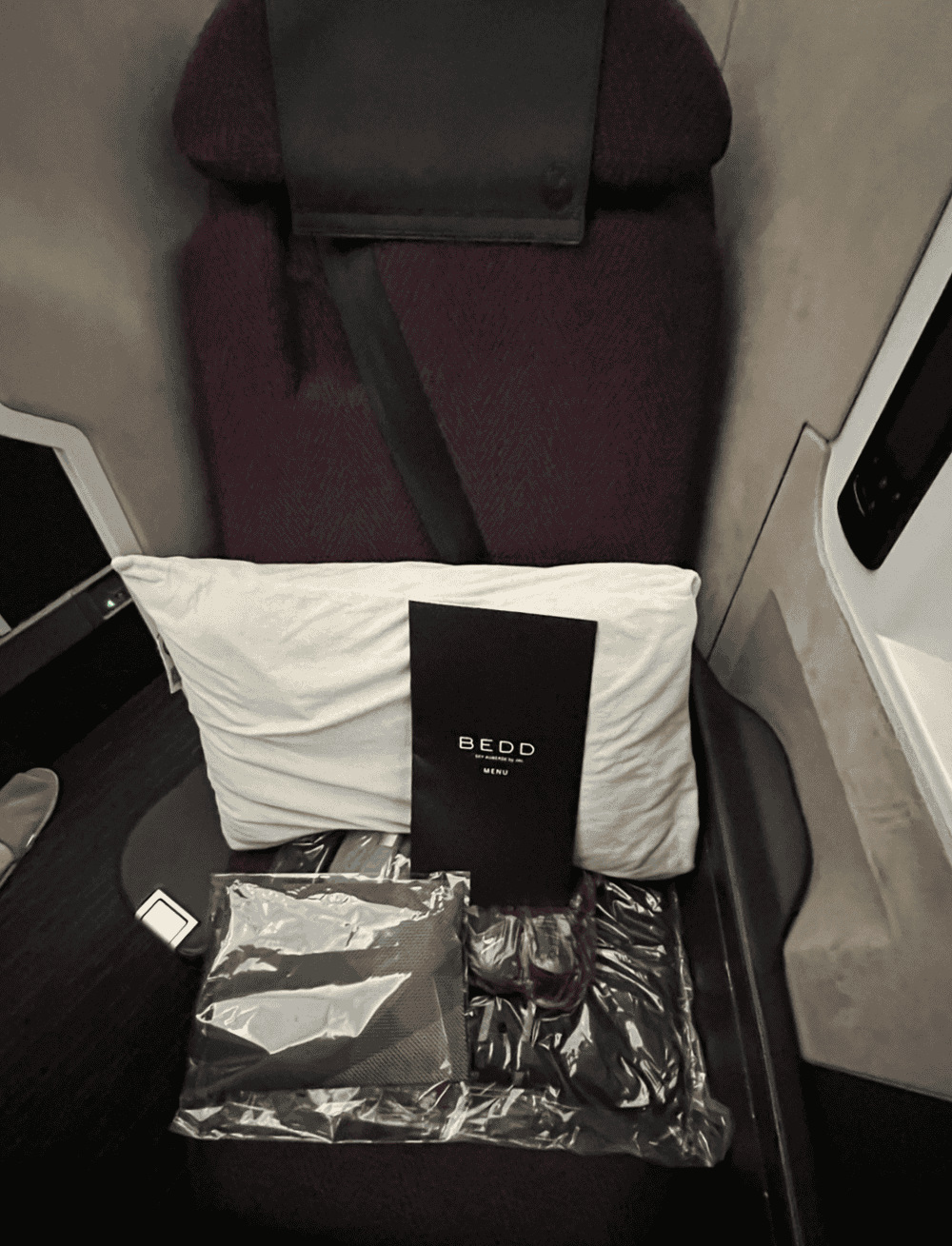
Japan Airlines 787-900 business class seat | Photo by Julie Neafach
Before takeoff, flight attendants offered each passenger a cardigan sweater, and shortly after takeoff, they offered a beverage service. Drinks were served on a tray with a packaged moist towel and two small packaged snacks.
There was one meal service: breakfast before arrival, with a choice of a western or Japanese breakfast set. The menu included a description of the breakfast choices and “anytime” snack options (as shown below) and also noted beverage choices.
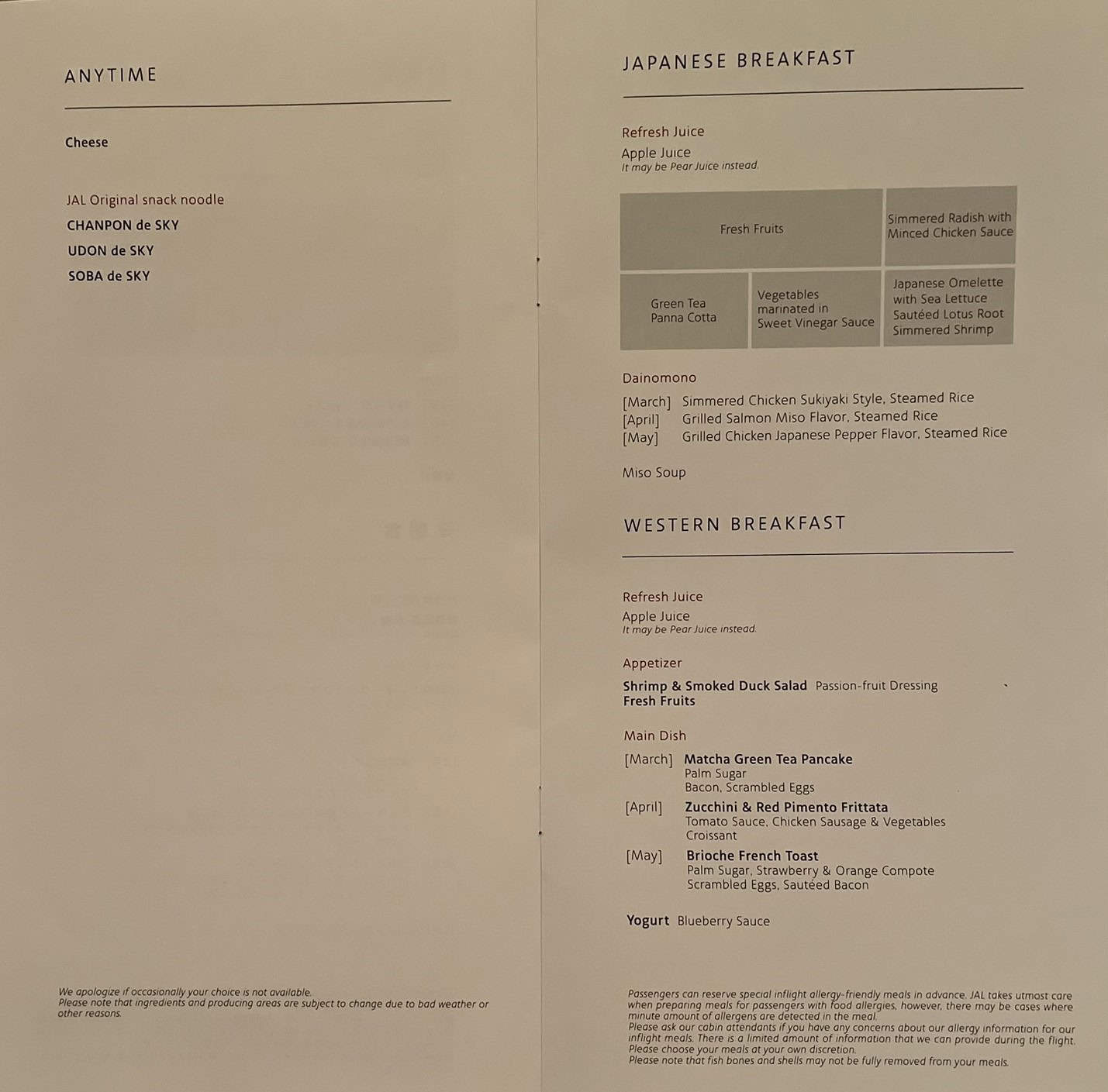
Japan Airlines business class menu | Photo by Julie Neafach
Meal orders were taken before takeoff, and breakfast was served about an hour before landing. I ordered the Japanese breakfast, which was nicely presented. The food quality and taste were good.
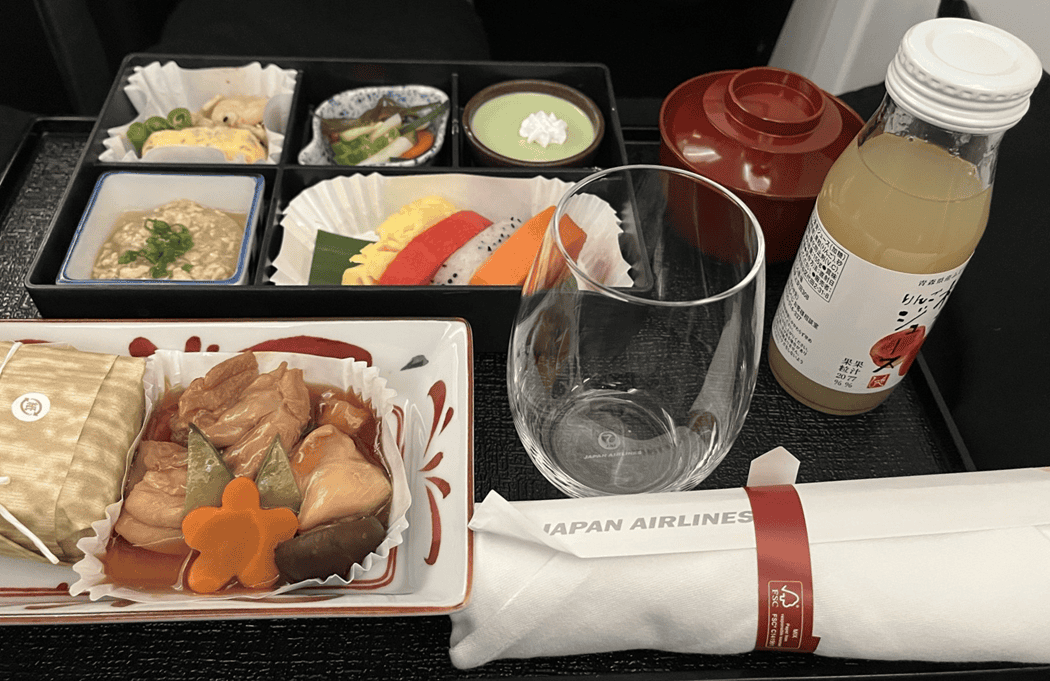
Japan Airlines Japanese breakfast | Photo by Julie Neafach
For such a short overnight flight where sleep was a priority, service was excellent. Noticing I was awake after the initial beverage service, a flight attendant offered me extra snacks. My birthday began on the overnight flight, and before landing, the flight attendants gave me a handwritten card and small bag with a model plane, a key chain and some packaged eye masks. All business class passengers were given eye masks before the end of the flight.
American Airlines Flights
Both American Airlines domestic flights were fairly standard. Both flights were on planes with economy- and first-class cabins and a 2-2 configuration with recliner-style seats in first class.
The transcontinental flight from San Diego was about 4.5 hours overnight with almost no service provided. The flight attendants offered pre-departure beverages and a beverage service with choice of a packaged snack just after departure. That was it.
Although I understand the desire to let people sleep on a short overnight flight, this was a reduction in service from the last time I flew American Airlines on a red-eye in two-cabin domestic first class in early 2020. On that flight, I was surprised that they served food on a plate; I selected a cheese plate. No blankets were provided on my flight from San Diego. Previously, blankets have been provided in American Airlines domestic first class.
Breakfast on the flight from Philadelphia (PHL) to Tampa (TPA) was quite good. There was no menu, and the flight attendants didn’t provide thorough descriptions of the food. My entrée was an egg dish with vegetables, and it was served with a sweet potato side dish, a scone and cut fruit. The other entrée option was a bagel with smoked salmon, served with the same fruit and packaged yogurt.
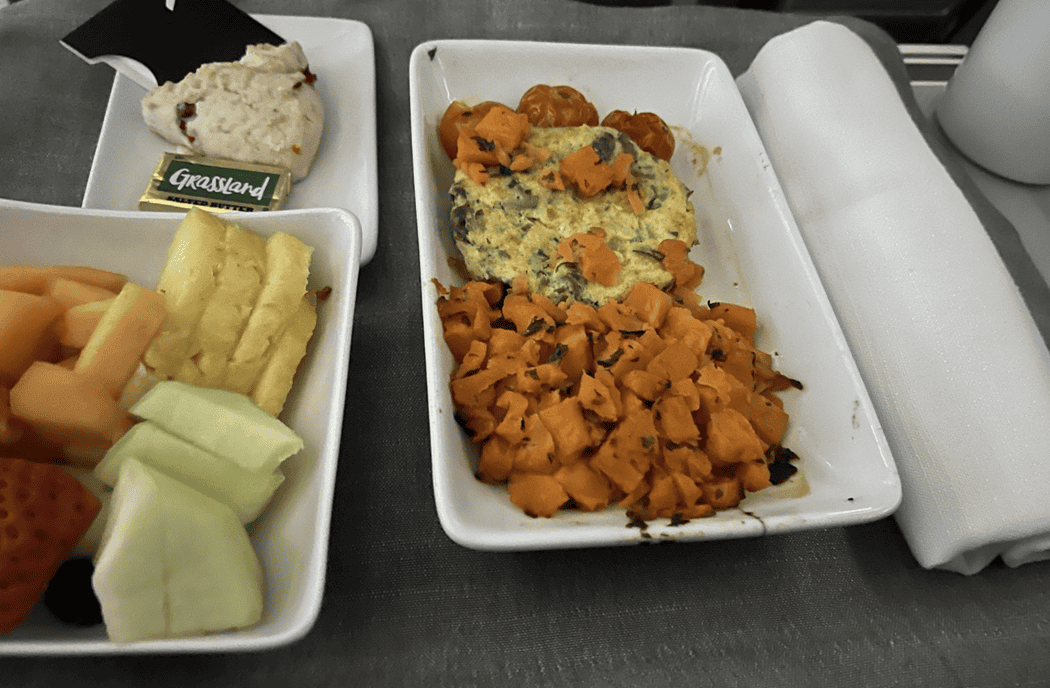
American Airlines business class breakfast | Photo by Julie Neafach
Airline Lounges
My itinerary also enabled me to visit several airline lounges. I discussed the lounges I visited in other flight reviews, and wrote more detailed lounge reviews for the United Polaris Lounge at Washington (IAD) and the Japan Airlines Sakura Lounge and First Class Lounge at Tokyo (NRT).
The Hotels I Chose to Stay At
I used a mix of accommodations on this trip, including international chain properties and Airbnbs. I wrote separate reviews for the following chain hotels where I stayed:
- Alila Kuala Lumpur Bangsar (Hyatt): This is a city hotel next to a transit station and near the Little India area and a central shopping and transportation center.
- DoubleTree by Hilton Resort Penang: This property is located on the main road on Penang Island in Malaysia. The hotel has a sea view, and it’s across the road from a small beach. There’s a bus stop in front of the hotel, but there aren’t many dining options or attractions near the hotel.
- Grand Hyatt Bali: This is a beachfront resort in the Nusa Dua area of Bali. The location is perfect for a resort stay on a nice beach, but the gated Nusa Dua community might not be ideal for people who want easy access to a busier city area.
Each of these locations had other international chain hotel options, but the properties I selected made sense given my top tier elite status in the Hilton Honors and World of Hyatt programs and my budget. Since this was a long trip for me, and I already had plans for more travel later in the year, I focused on obtaining good value in fairly nice hotels, rather than spending significantly more points or money for more luxurious hotels.
Before choosing hotels, I considered other Hilton and Hyatt properties in Kuala Lumpur and Penang that might be good options for others.
- Kuala Lumpur: Grand Hyatt Kuala Lumpur, DoubleTree by Hilton Kuala Lumpur and Hilton Kuala Lumpur: The Grand Hyatt, which was a Category 3 property at the time of writing, is conveniently located for visiting the most popular Kuala Lumpur tourist attraction, the Petronas Twin Towers, and is close to popular upscale shopping and dining areas. The DoubleTree is about a 15 to 20 minute walk to the Petronas Twin Towers and has nearby transit, shopping and dining. I stayed at the DoubleTree in 2017 for 10,000 Hilton points per night, but the points price was much higher when I checked availability for my 2023 trip. The Hilton is located close to KL Sentral, which is the primary transit hub and also has shopping and dining nearby. Hilton Honors award pricing is variable. Comparing the two Hilton properties, Hilton Kuala Lumpur award and cash prices typically are higher than the DoubleTree.
- Penang: The Edison is located in the heart of George Town in a heritage building. I stopped there one day and thought that the public areas looked nice, but as a small property in a historic building, facilities are limited. At the time of my trip, The Edison could be booked with World of Hyatt points (Category 3), or points could be earned on paid stays, through Hyatt’s partnership with Small Luxury Hotels (SLH). In early 2024, plans were announced for the relationship between Hyatt and SLH ending and Hilton and SLH entering into a partnership. So, the property might be bookable through Hilton in the future.
I also stayed at Airbnbs in Penang and Hanoi. Although I have stayed in condominiums that are managed like hotel rooms or used VRBO in the past, these stays were my first two experiences using Airbnb. Both stays were fine. The decision to book through Airbnb was driven by having credits specifically for vacation rentals from my Capital One Venture X Rewards Credit Card. This credit was part of the welcome offer when the card was launched in late 2021.
Final Thoughts
Overall, I had a great trip to Southeast Asia and was relieved that my flights operated without disruptions or major delays. While adjusting to the time and climate differences was more difficult than it has been on past trips, I was excited to return to this region, and I’m returning to Southeast Asia in 2024.
New to the world of points and miles? The Chase Sapphire Preferred® Card is the best card to start with.
With a bonus of 75,000 bonus points after you spend $5,000 on purchases in the first 3 months from account opening. , 5x points on travel booked through the Chase Travel Portal and 3x points on restaurants, streaming services, and online groceries (excluding Target, Walmart, and wholesale clubs), this card truly cannot be beat for getting started!
Editors Note: Opinions expressed here are author’s alone, not those of any bank, credit card issuer, hotel, airline, or other entity. This content has not been reviewed, approved or otherwise endorsed by any of the entities included within the post.








